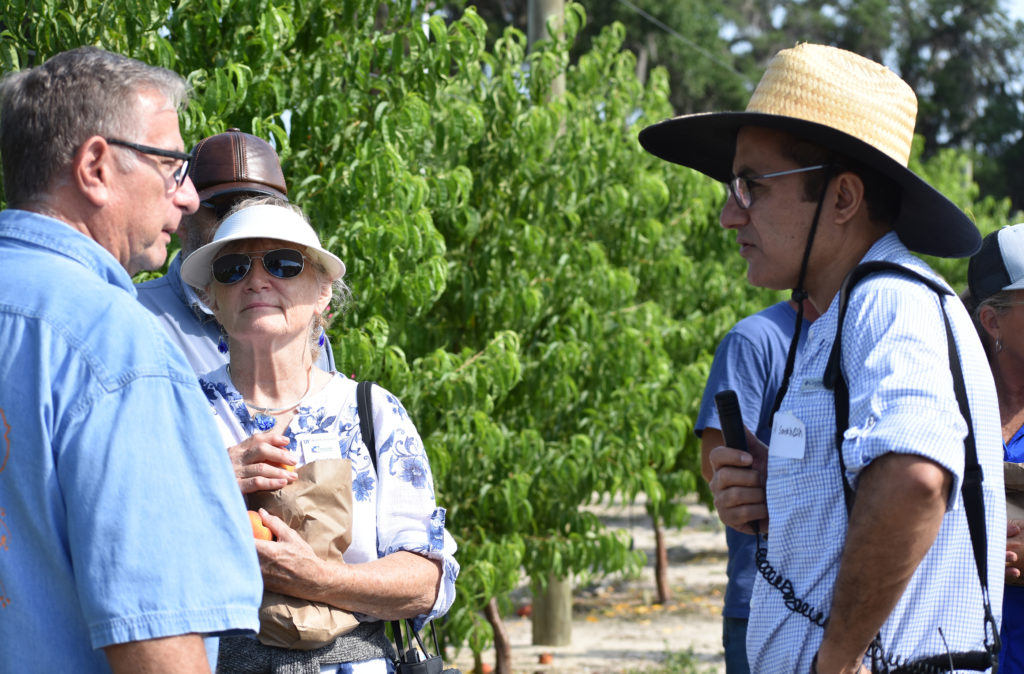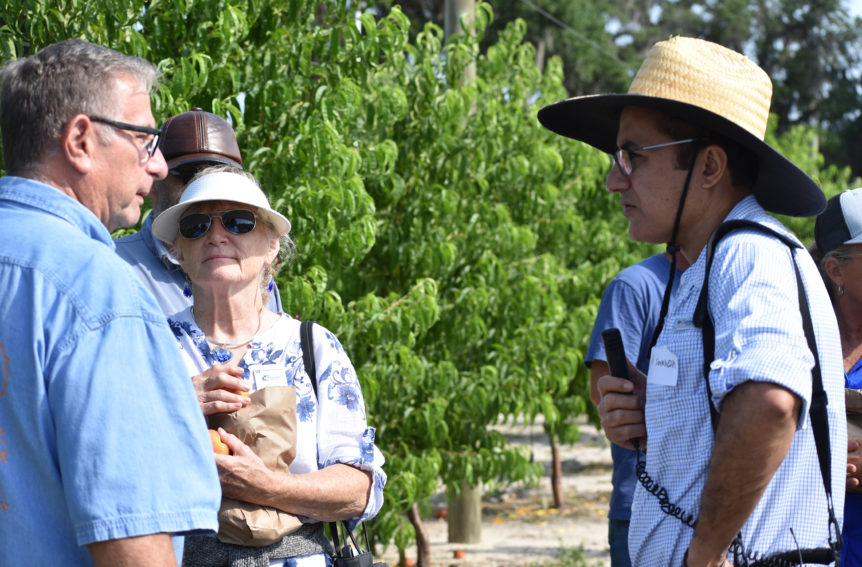
Photos by Clint Thompson
By Clint Thompson
The future of Florida’s peach industry potentially rests on results generated from research at the University of Florida Institute of Food and Agricultural Sciences (UF/IFAS).
With labor expenses at an all-time high and showing no signs of slowing, Florida’s peach growers need a more efficient way to produce a crop that is heavily reliant on manual labor. UF/IFAS scientists are confident they will have a potential solution.
Research plots at the UF/IFAS Plant Science Research and Education Unit in Citra focus on peach production in high-density orchards. The study includes increased trees per acre, higher yields and automation to handle more of the manual labor tasks associated with peach production, specifically pruning.
Ali Sarkhosh, UF/IFAS assistant professor in horticultural sciences, led Florida growers on a tour of the high-density orchards in Citra at a Stone Fruit Field Day in early May.
“The high-density research is to see how we can cut labor costs. Labor costs are one of the big issues for the peach grower,” Sarkhosh said. “Growers have to spend a lot of time on pruning and fruit thinning. We’re hoping this high density can incorporate more machinery and mechanization to reduce labor costs.”
The high-density orchards allow for 280 trees per acre at a spacing of 12 by 13 feet, compared to traditional orchards that allow for 136 trees per acre at a spacing of 16 by 20 feet. The high-density setup is ideal for machines to prune much of the trees, reducing the time and labor needed for a key time of peach season.
“The heavy pruning will be done by machines. The detailed pruning will still be done by people,” said Jose Chaparro, UF/IFAS associate professor of horticultural sciences. “Imagine a scenario where you have a wall, and the very center of the wall, 6 to 8 inches to the right, you have fruiting wood, and 6 to 8 inches to the left, you have fruiting wood. Your hedger goes down the row, and you hedge at that distance.”
Chaparro added that not all current varieties are suited for this type of production, though ongoing research is geared toward high-density production. Varieties like Florida Best and Ruby are recommended.
Labor Cost Concerns
Florida employs the most H-2A workers in the country with 47,396 certified positions in 2024, at an adverse effect wage rate of $16.23. This rate represents a 9.9% increase from the previous year.
UF/IFAS estimates $2,500 per acre for labor in peach production. But high-density orchards could save growers almost $1,000 per acre.
While additional years of research are needed, the work has already provided hope to the industry, says Chaparro.
“It’s not an option; we have to do it,” Chaparro said. “I’m very excited about it. I think there’s a lot of potential. We expect the data to show you’re going to get a significant increase in yield.”
Climate Change
Like other crops in Florida, peaches have been impacted by climate change. Warmer winters and growing seasons have decreased the number of chill hours available for peach farmers to produce a consistent crop. It has forced growers to expand the growing region beyond its normal area.
“Some growers who are able to are moving north,” Chaparro said. “We’re still keen on developing an industry and expanding it. As climate change rears its ugly head, it’s going to move. Things will change in Georgia, too. You will probably see varieties that were grown in the Coastal Plain move into Central Georgia.”
A peach industry in Florida is still enticing considering how much earlier fruit can reach the market compared to other peach-producing states like Georgia. Some growers started harvests this year as early as April 1, with most picking by April 15. Chaparro said if growers experience a cool November, harvests could begin as early as the last week of March.










